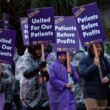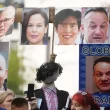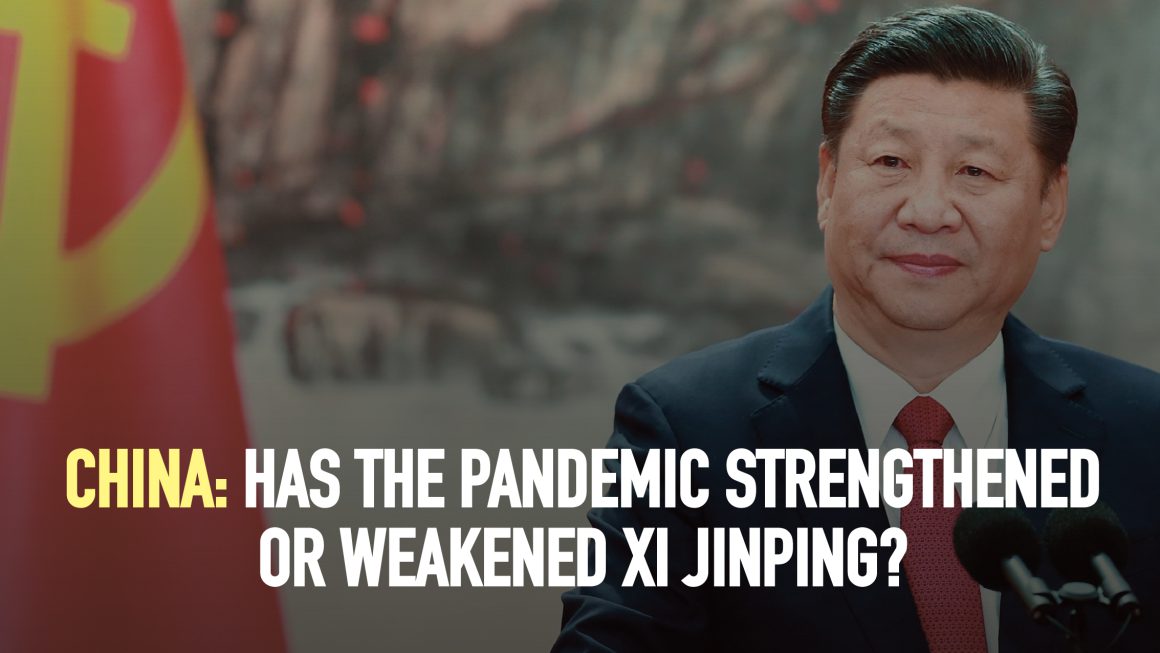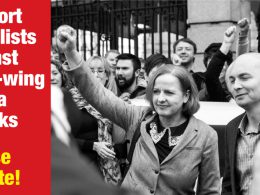By Vincent Kolo, chinaworker.info
On 15 June the National Bureau of Statistics cancelled its press conference in Beijing. It was due to present May’s economic data, showing that China’s economy continues to “gain momentum” following the shocking crash of the first quarter.
The cancellation was forced by the new wave of coronavirus infections in Beijing, which caused authorities to sharply reverse plans to fully re-open the city. Schools, which only re-opened the previous week, were again closed and 40 percent of flights from the capital’s two airports were cancelled. Over 90,000 residents near the outbreak’s centre were put under strict lockdown with armed police cordoning off the area.
The new outbreak, with almost 200 confirmed cases in one week, is linked to the city’s biggest wholesale food market at Xinfandi. It came like a lightning bolt from a clear blue sky. Beijing had not reported a single new case of Covid-19 for 55 days. That this has happened in the capital, the Chinese dictatorship’s seat of power, is both chilling and embarrassing for Xi Jinping following months of propaganda claiming China’s “victory” over the pandemic.
It underlines a bigger global problem: that much is still unknown and unpredictable about Covid-19 and governments that are everywhere rushing to re-start profit-making economic activities are still cutting corners where public health is concerned. The World Health Organisation warns that a second wave of the pandemic is “a very real risk”.
Unprecedented crisis
The pandemic and the global economic crisis are bringing fundamental and historic changes. Global capitalism as a whole including China’s authoritarian state-guided capitalism have decisively failed this test. Humanity faces a period of economic depression, record unemployment and sharply deteriorating international relations.
Xi’s regime has attempted to shield itself from a massive global blowback. Rival capitalist governments, most notably Trump in the US, want to place the whole blame on China for the health and economic crisis, while of course hiding their own crimes. Above all the CCP is concerned about public opinion at home — more than its global reputation. Favourable reports in global media or praise from foreign governments mainly have value for the CCP in showing Chinese people the regime is respected. With unemployment soaring in China and the economy in a worse plight than at any time in the past 40 years, Xi’s regime is desperate to generate “positive news” while tightening its crackdown on dissenting voices from whichever direction.
Since March, to improve its image, Beijing has engaged in global “mask diplomacy” selling or donating over 4 billion facemasks worldwide. The shocking incompetence of the US government’s response, which pushed it to the number one spot for Covid-19 infections and deaths, enormously helped the CCP’s propaganda campaign.
But despite this the regime is facing a storm like no other, certainly the most serious since the mass anti-authoritarian struggle of 1989.
In fact, a leaked internal report of the China Institutes of Contemporary International Relations (CICIR), a think-tank affiliated to the Ministry of State Security, warned that the rising global tide of anti-China sentiment in the wake of Covid-19 is the worst since the Tiananmen massacre of June 1989. The leak itself, published by Reuter in May, could be connected to the intensifying power struggle within the Chinese regime.
It is clear that a growing wing of the CCP regime are increasingly disquieted by the aggressive “wolf warrior” diplomacy which has become the new normal for China’s foreign diplomats in 2020. This flows from Xi’s increasing dependence on ever more nationalistic policies on, amongst others, the pandemic, the South China Sea, the US-China conflict, Hong Kong and Taiwan in order to drum up domestic support and divert attention from the crippled economy.
This is a dangerous dynamic as underlined by the conflict on the border with India in the high reaches of the Ladakh region in the Himalayas, where Chinese and Indian troops have clashed repeatedly since early May. In June this conflict escalated with 20 Indian soldiers killed while China has refused to reveal its own casualties. While the two sides have clashed before, these were the first fatalities for 45 years.
Both governments — almost like a mirror image of each other — rely heavily on nationalism to shore up their rule, something the pandemic has accentuated. Both sides have recently strengthened their defences and infrastructure on each side of the disputed border. The recent conflict is an attempt by both sides to increase pressure on each other before eventual negotiations, as took place in Wuhan in 2018. Neither Delhi or Beijing are looking to go to war, but both sides’ actions are infecting old wounds.
This is one front in the sharpening power struggle inside the CCP, with Xi’s hardline foreign policy seen by some as increasingly counterproductive, alienating and pushing foreign governments into the US camp in the burgeoning Cold War. A layer would prefer a return to the CCP’s traditional pragmatism and a more tactful approach. China’s diplomats were once known for being “well-trained, colourless, and cautious” says US-based commentator Minxin Pei. He bemoans the rise of such figures as Zhao Lijun, deputy director of the Chinese Ministry of Foreign Affairs Information Department, a prominent representative of the “wolf warrior” class.
The new strident tone, amplified by the pandemic, has caused a deepening backlash in Australia, Southeast Asia, several African countries and the EU, pushing some of these governments closer to the US position of military containment and economic decoupling from China. Of course this is not just about ‘tone’ and clumsy diplomacy, but the fear among the capitalists in other countries that this crisis tilts global power in China’s favour. Xi’s unilateral abolition of Hong Kong’s limited political autonomy, a move designed to bolster his domestic strongman image, has only reinforced these fears. Even the Philippines, which under Duterte has moved much closer to China, recently reversed its decision to end a military pact with the US.
Desperate economic situation
Foreign policy is a continuation of domestic policy. That Xi’s regime is flexing its muscles from the Indian border to the South China Sea is a reflection of its insecurity in the face of the deepening global and domestic crisis.
China’s recent economic data is rather contradictory. The monthly data for May, which the NBS had intended to present at its cancelled Beijing press conference, shows a further rebound in industrial production, up 4.4 percent from a year earlier, and within this a 5.2 percent increase in manufacturing output. But while these figures suggest China’s industry is ‘recovering’, the bigger question is where will it sell its goods?
“Supply is significantly exceeding demand,” stated Larry Hu Weijun, chief China economic expert at the Macquarie Group (Australia). The problem is underscored by May’s retail sales figures showing a fall of 2.8 percent. This follows contractions of 7.5 percent in April and 15.8 percent in March. If the capitalists cannot sell their goods due to depressed demand at home and in overseas markets, then they won’t invest in increased production no matter what tax incentives and credit easing measures are offered. For the first five months of 2020 investment in the manufacturing sector declined by 14.8 percent. It is hard to envisage a worse performance in the “worlds’ factory”.
At the NPC in May, Beijing shifted its focus from chasing a GDP target to employment: staunching the collapse of the job market. Some regime economists still believe the economy can achieve 2–3 percent growth in 2020, while the IMF in April forecast only 1.2 percent.
China’s official unemployment figure is 6 percent, but few believe this. Even based on this low-end estimate, which only covers the urban, wealthier half of the population, 26 million are currently unemployed. Yet less than one in ten (2.3m) are receiving unemployment assistance, with the average per capita payout just 1,350 yuan (US$190) per month based on Ministry of Human Resources and Social Security data for March.
While this is bad enough, the real picture is much worse. No official figures are provided for unemployment among China’s 290 million migrant workers, who are classified as “rural” under hukou rules and make up 36 percent of the workforce. In March, as the lock-downs and travel bans were being lifted, only 129 million — less than half — of these workers had returned to employment.
By April, according to the National Statistics Bureau, the number of migrant workers who had returned to their cities of employment was at 90 percent of levels in previous years, indicating that almost 30 million had still not returned. Independent studies indicate a much lower return to work.
“In late April, only about half of those rural workers who were working last year were [still] working,” said Scott Rozelle, an economist who led a study by researchers at Stanford University and Renmin University in Beijing based on samples earlier this year with nearly 700,000 villagers from seven Chinese provinces. The crisis has “so dramatically reduced migrant workers’ incomes that most have been forced to buy less food,” this study found (Emily Feng and Amy Cheng, NPR, June 8, 2020).
In many cases, migrants found the new jobs awaiting them in the industrial provinces were on lower pay than before the pandemic, with wage reductions of around fifty percent reported from the Pearl River Delta. Factories could only offer a standard workweek without overtime, but migrants have never been able to survive on their basic pay without long hours of overtime.
Some unofficial but credible estimates say that China’s real unemployment rate could now be around 20 percent, with up to 80 million migrants unable to find jobs and returning to their villages because the wages offered do not support life in the cities where costs are high.
Still poor
In May, at the press conference that always follows the annual NPC session, Premier Li Keqiang dropped a political bombshell. He remarked that China has 600 million people (43 percent of its population) with a monthly income not more than 1,000 yuan (US$140).
“It’s not even enough to rent a room in a medium Chinese city,” the Premier said, shocking many listeners whose perception was that such extreme hardship no longer exists in China, not on such a colossal scale. Li’s moment of honesty demolished at one stroke the CCP’s keynote propaganda claim that China will by next year become a “moderately prosperous society” (by doubling 2010 per capita GDP).
In the following days, Premier Li also gave his personal endorsement to the creation of a “stall economy” as a means to generate employment in the current crisis. Overnight, “stall economy” became a major trending topic on social media and there was even a buying boom for shares in companies linked to this idea. Li praised Chengdu’s city government for allegedly creating 100,000 jobs by opening facilities to support street vendors. It was reported that 27 other cities are promoting similar policies.
This changed dramatically, however, with the Beijing municipal government, which is factionally allied with Xi Jinping, denouncing the stall economy concept as “unhygienic and uncivilised”. This marked a sudden policy swing and within days the “stall economy” policy was largely expurgated from official media.
Neither Li’s promotion of the “stall economy”, or the push-back seemingly coming from Xi’s camp, represent policies in the interests of the working class. Eking out a living by peddling on the streets is no alternative for real jobs and shuttered factories. But the campaign to block Li’s policy is not grounded in offering alternative support for the poor and jobless masses. It reflects the CCP’s elitist contempt, especially in major cities like Beijing, towards the “low-end population” who in many cases have been uprooted and driven out of these cities in mass expulsion campaigns over recent years. The CCP’s urbanization strategy increasingly resembles segregation and a form of Chinese apartheid to reserve the major cities for “civilized” sections of the population.
Power struggle
At the same time this policy dispute reflects a more fundamental process: the reopening of the fierce power struggle within the CCP which we were told belonged to the past. With Xi succeeding in abolishing presidential term limits in a 2018 constitutional change, he had allegedly fully consolidated his hold on the regime and was moving unchallenged towards a third term in power. This no longer looks so certain.
Li Keqiang’s recent role, and sympathy for him among a section of the masses on the basis of a more ‘populist’, humble, and man-of-the-people image, suggests the Band-Aid that had been placed over the internal factional struggle has been ripped off. Not since Xi ascended to power has such a public and personalised conflict erupted within the regime — and this centred on its two most prominent figures.
The reaction from state-controlled media (under the CCP’s Propaganda Department which is controlled by Xi Jinping’s camp) has been immediate and overwhelming, going far beyond clamping down on the “stall economy” issue. Speeches by Li Keqiang are now being deleted or changed. The last time this happened to a Chinese Premier, formally the second-ranking official in the state hierarchy, was against Zhou Enlai during the Cultural Revolution (1966–76).
Li of course represents the tuan pai (so-called Young Communist League) faction within the CCP, which has been pushed back and driven from many of its positions during eight years of Xi Jinping rule. But Xi’s hardline power struggle tactics and increasingly serious policy setbacks at home and internationally, could see new factional combinations come to the fore, whether or not Premier Li is their standard bearer, to challenge Xi’s position in the next period.
For socialists, the shifting of tectonic plates within the Chinese regime is an important portent of the social and political upheavals that lay ahead. Revolution, as the saying goes, starts at the top. We do not place any confidence in any wing of the thoroughly bourgeois, thoroughly authoritarian CCP apparatus. We stand for independent working class struggle in China and globally around the program of socialism and a genuine working class government.











